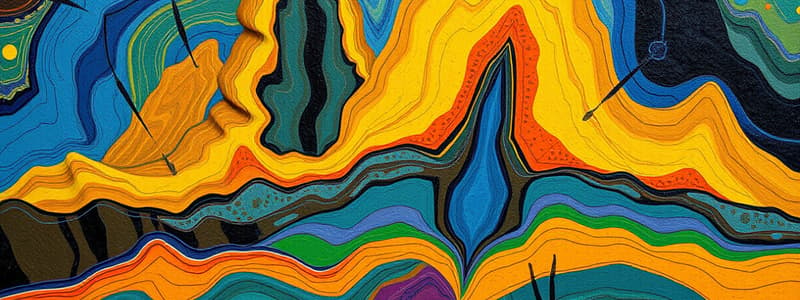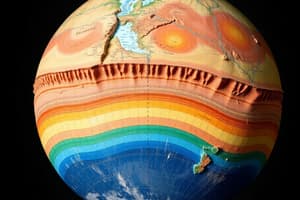Podcast
Questions and Answers
What phenomenon describes the increase in global temperatures due to greenhouse gases?
What phenomenon describes the increase in global temperatures due to greenhouse gases?
- Greenhouse Effect
- Climate Change
- Ozone Depletion
- Global Warming (correct)
Which term describes the state of the atmosphere in terms of temperature, wetness, and calmness?
Which term describes the state of the atmosphere in terms of temperature, wetness, and calmness?
- Climate
- Meteorology
- Weather (correct)
- Atmosphere
What is the term for the rotating column of air that can cause significant damage?
What is the term for the rotating column of air that can cause significant damage?
- Typhoon
- Hurricane
- Cyclone
- Tornado (correct)
What structure surrounds the center of a hurricane and is key to its formation?
What structure surrounds the center of a hurricane and is key to its formation?
What type of seismic wave is typically the most destructive during an earthquake?
What type of seismic wave is typically the most destructive during an earthquake?
Which of the following processes explains the movement of tectonic plates?
Which of the following processes explains the movement of tectonic plates?
What term is used for an area along a fault where earthquakes occur frequently?
What term is used for an area along a fault where earthquakes occur frequently?
What type of volcano is known for being the largest?
What type of volcano is known for being the largest?
What are the three types of plate boundaries?
What are the three types of plate boundaries?
What is the point within Earth where an earthquake starts called?
What is the point within Earth where an earthquake starts called?
What is the name of the instrument used to record seismic waves?
What is the name of the instrument used to record seismic waves?
What is an area along a fault where there has not been any earthquake activity for a long period of time known as?
What is an area along a fault where there has not been any earthquake activity for a long period of time known as?
What type of volcano is built almost entirely of fluid lava flows?
What type of volcano is built almost entirely of fluid lava flows?
What is the natural warming of Earth's lower atmosphere and surface referred to as?
What is the natural warming of Earth's lower atmosphere and surface referred to as?
What are the two main types of seismic waves?
What are the two main types of seismic waves?
What scale is based on earthquake intensity?
What scale is based on earthquake intensity?
Flashcards are hidden until you start studying
Study Notes
Plate Tectonics and Earthquakes
- Earth's outer shell is formed by large, irregularly shaped slabs called Lithospheric Plates.
- The Theory of Plate Tectonics describes the movement of these lithospheric plates.
- There are three main types of plate boundaries: Divergent, Convergent, and Transform Fault.
- The focus is the point within the Earth where an earthquake begins, while the epicenter is the surface location directly above it.
- Earthquakes are explained by the Elastic Rebound Hypothesis, which describes how energy is released.
- Seismic waves are divided into two categories: Body Waves and Surface Waves; with P waves (primary) and S waves (secondary) as the types of body waves.
- Surface waves are known to be the most destructive during an earthquake.
- An instrument called a Seismograph is used to record seismic waves, producing a visual output known as a Seismogram.
- Earthquake magnitude is measured by the Richter scale and the Moment Magnitude scale, while intensity is evaluated using the Modified Mercalli scale.
- Liquefaction is a phenomenon where saturated soil and rock behave like a liquid during an earthquake.
- A Tsunami can occur when the ocean floor shifts suddenly due to an earthquake.
- Seismic Gaps indicate areas along faults that have not seen earthquake activity for an extended period.
Volcanoes
- A Volcano is a landform created by molten rock erupting through the Earth's surface.
- Volcanoes are categorized as Active (currently erupting), Dormant (inactive but could erupt), and Extinct (no longer active).
- The Cinder Cone is the simplest type of volcano, while Composite Volcanoes are known as Stratovolcanoes.
- Shield Volcanoes are primarily composed of fluid lava flows.
Weather and Climate
- Climate refers to the long-term weather patterns in a specific area.
- There are three primary climate zones: Tropical, Temperate, and Polar.
- The Greenhouse Effect refers to the natural warming of Earth's atmosphere and surface.
- Global Warming is the increase in Earth's temperatures due to higher greenhouse gas concentrations.
- Weather refers to the atmospheric conditions at a given time, including temperature and moisture.
Storms
- A Thunderstorm is characterized by lightning and thunder.
- A Tornado forms as a violent windstorm with a rotating column of air.
- The Eye Wall is a doughnut-shaped area surrounding the center of a hurricane, while the Eye is the calm center with decreased precipitation and winds.
- A Storm Surge refers to a dome of water that moves inland as a hurricane makes landfall.
Faults and Tectonic Movement
- There are three primary types of faults: Normal, Reverse/Thrust, and Strike-slip.
- Surface waves can be categorized into two types: Love Waves and Rayleigh Waves.
- Convection Currents are the driving force behind plate tectonic movements.
True/False Statements
- Plate tectonics are dynamic and continuously moving (False).
- The lithosphere consists of several tectonic plates (True).
- Divergent boundaries form when two plates converge (False).
- The focus is inside the Earth, while the epicenter is on the surface (True).
- The elastic rebound hypothesis describes how energy is released during quakes (True).
- P waves travel faster than S waves (True).
- Surface waves are indeed the most destructive type of seismic wave (True).
- Seismograms capture the timeline of ground motion during an earthquake (True).
- The Richter and moment magnitude scales assess earthquake magnitude (True).
- Liquefaction turns solid ground into a liquid state during quakes (True).
- Tsunamis can arise from seismic activity underwater (True).
- Seismic gaps indicate frequent earthquake activity (False).
- Volcanoes are formed by magma from beneath the Earth's crust (True).
- Active volcanoes are currently in eruption or expected to erupt soon (True).
- Dormant volcanoes are thought to erupt imminently (False).
- Extinct volcanoes are not expected to erupt again (True).
Studying That Suits You
Use AI to generate personalized quizzes and flashcards to suit your learning preferences.



